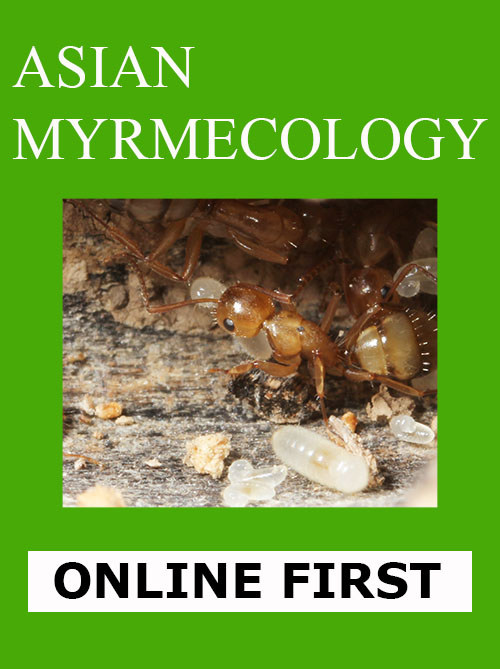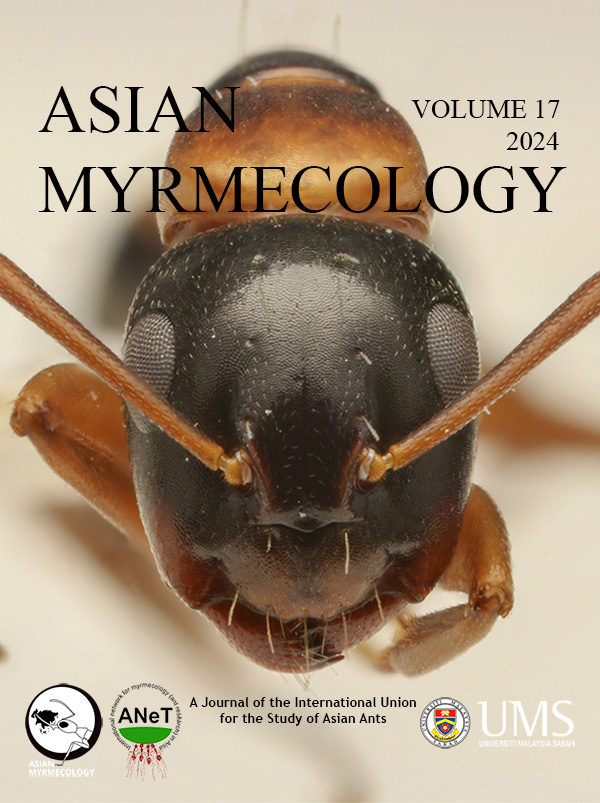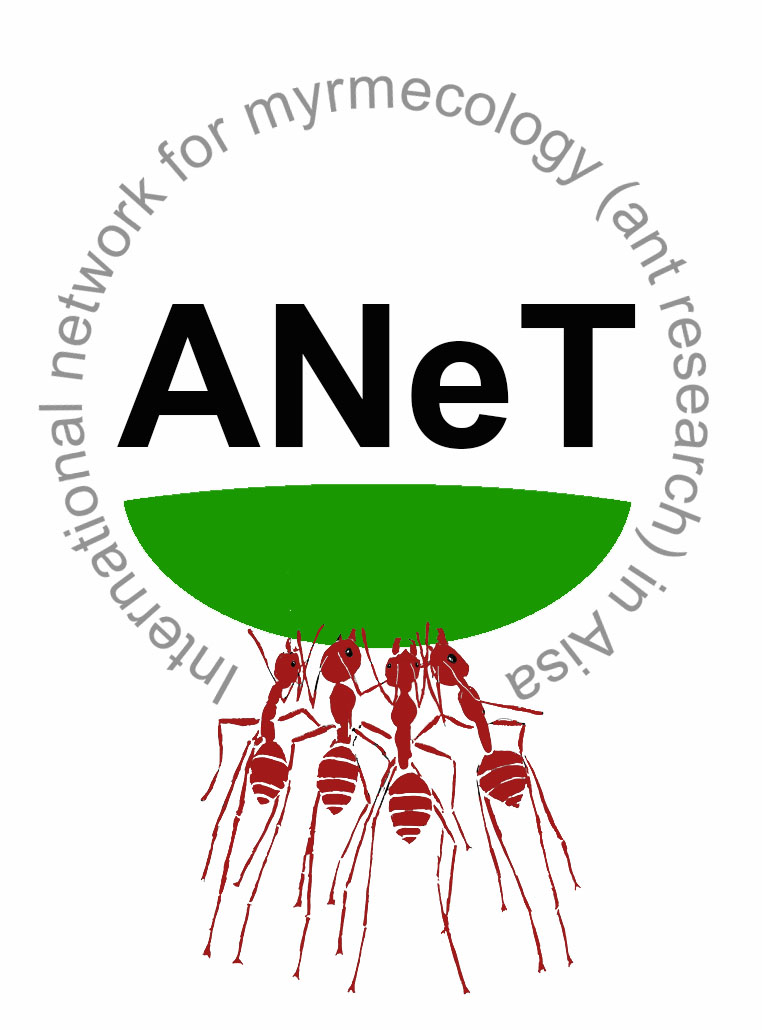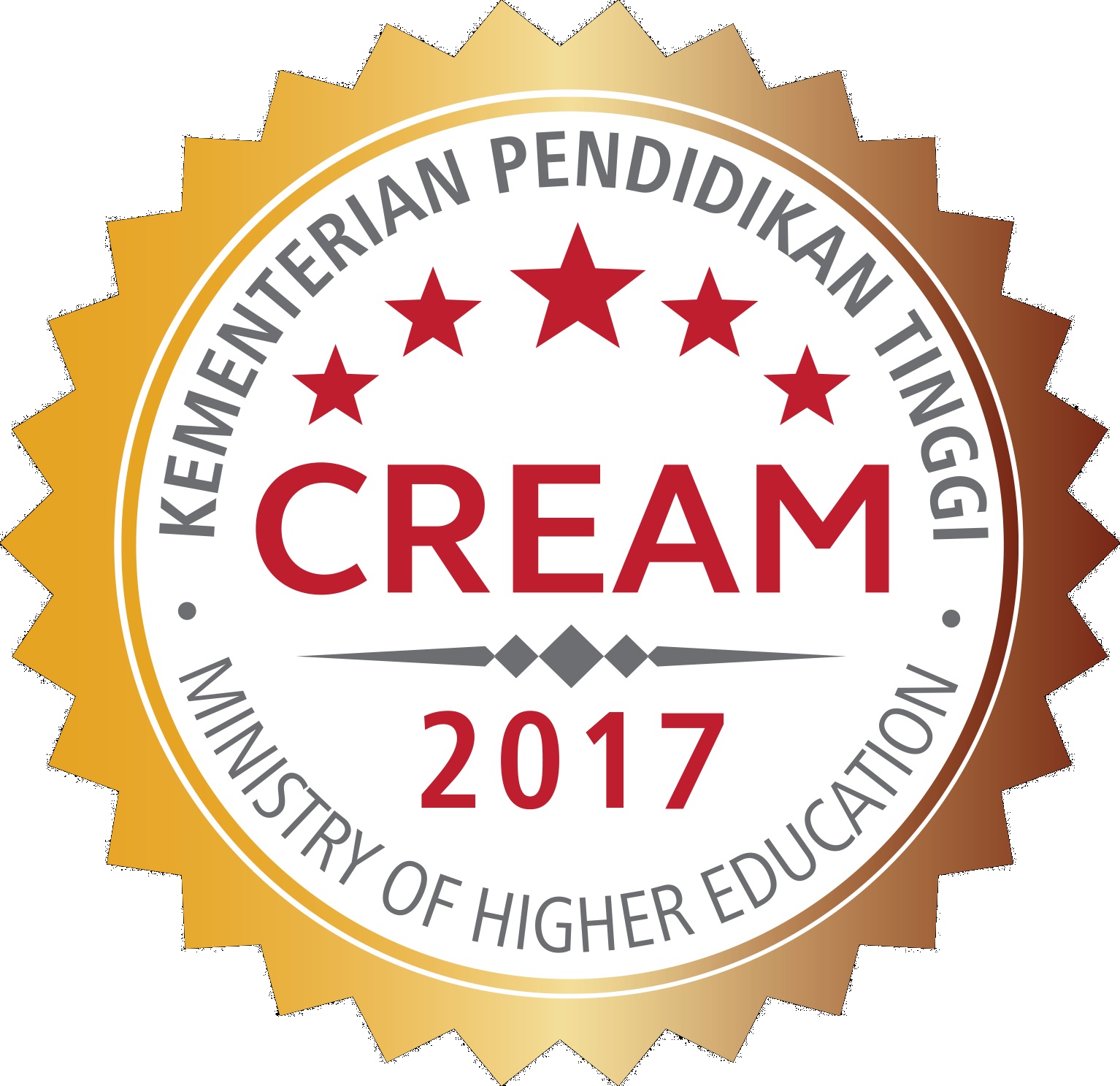ASIAN
MYRMECOLOGY
Image: François Brassard
online first (online version of paper published before print issue)
DOI: 10.20362/am.018002
Asian Myrmecology 18: 018002 (1-12)
article first published online: 1/April/2025
Ant species on a facultative ant-plant (Macaranga tanarius) and their possible roles in herbivory protection
ZHI HOONG WONG1, HONG LIANG TAN2, DENIECE YIN CHIA YEO3 & SZE HUEI YEK4*
Abstract:
Protective mutualism between ants and Macaranga genus plants ranges from obligate to facultative interactions. Unlike obligate ant-plant interactions, facultative mutualists like Macaranga tanarius lack specialized structures to house ant symbiont colonies but offer food rewards such as extrafloral nectary secretions and food bodies. These rewards attract opportunistic foraging ants that provide defense against insect herbivores. We hypothesized that the efficacy of this defense depended on the composition of the ant species. We assessed insect herbivory by recording leaf damage and monitored ant activity at different times of the day. We also conducted behavioral assays to test ants’ response toward offered wax-moth larvae prey (representing lepidoptera larva that causes most leaf-loss damage of M. tanarius). Ant community composition did not differ between day and dusk, with almost half of the species (48.4%) active at both times. Saplings with foraging ants showed a trend of higher leaf loss (mean = 2.13%) than saplings without ants (mean = 1.32%), contrary to our expectations, although this difference was not statistically significant. This could be due to the short observation time in this study, as herbivore attacks on leaf loss may be accumulated over a longer period. Most ant visitors on M. tanarius, which relied on herbivory diets, ignored the prey items; only the yellow crazy ant Anoplolepis gracillipes consistently attacked offered prey. Future research should be carried out over a longer period, and the abundance of ant species patrolling M. tanarius should be recorded to understand the potential roles of ants on these plants.
Keywords:
extrafloral nectary secretions, food bodies, wax-moth larvae, Anoplolepis gracillipes,
Get PDF (2.4 MB) :
ZHI HOONG WONG1, HONG LIANG TAN2, DENIECE YIN CHIA YEO3 & SZE HUEI YEK4*
Abstract:
Protective mutualism between ants and Macaranga genus plants ranges from obligate to facultative interactions. Unlike obligate ant-plant interactions, facultative mutualists like Macaranga tanarius lack specialized structures to house ant symbiont colonies but offer food rewards such as extrafloral nectary secretions and food bodies. These rewards attract opportunistic foraging ants that provide defense against insect herbivores. We hypothesized that the efficacy of this defense depended on the composition of the ant species. We assessed insect herbivory by recording leaf damage and monitored ant activity at different times of the day. We also conducted behavioral assays to test ants’ response toward offered wax-moth larvae prey (representing lepidoptera larva that causes most leaf-loss damage of M. tanarius). Ant community composition did not differ between day and dusk, with almost half of the species (48.4%) active at both times. Saplings with foraging ants showed a trend of higher leaf loss (mean = 2.13%) than saplings without ants (mean = 1.32%), contrary to our expectations, although this difference was not statistically significant. This could be due to the short observation time in this study, as herbivore attacks on leaf loss may be accumulated over a longer period. Most ant visitors on M. tanarius, which relied on herbivory diets, ignored the prey items; only the yellow crazy ant Anoplolepis gracillipes consistently attacked offered prey. Future research should be carried out over a longer period, and the abundance of ant species patrolling M. tanarius should be recorded to understand the potential roles of ants on these plants.
Keywords:
extrafloral nectary secretions, food bodies, wax-moth larvae, Anoplolepis gracillipes,
Get PDF (2.4 MB) :
Get Electronic Supplementary Table 1 (20kB):
Get Electronic Supplementary Table 2 (20kB):
1School of Pathways and Immersion, Monash University Malaysia, Jalan Lagoon Selatan, 47500 Bandar Sunway, Selangor Darul Ehsan, Malaysia
2School of Science, Monash University Malaysia, Jalan Lagoon Selatan, 47500 Bandar Sunway, Selangor Darul Ehsan, Malaysia
3Education Excellence, Monash University Malaysia, Jalan Lagoon Selatan, 47500 Bandar Sunway, Selangor Darul Ehsan, Malaysia
4Institute for Tropical Biology & Conservation, Universiti Malaysia Sabah, Jalan UMS, 88400 Kota Kinabalu, Sabah, Malaysia
*Corresponding author: szehuei@ums.edu.my



